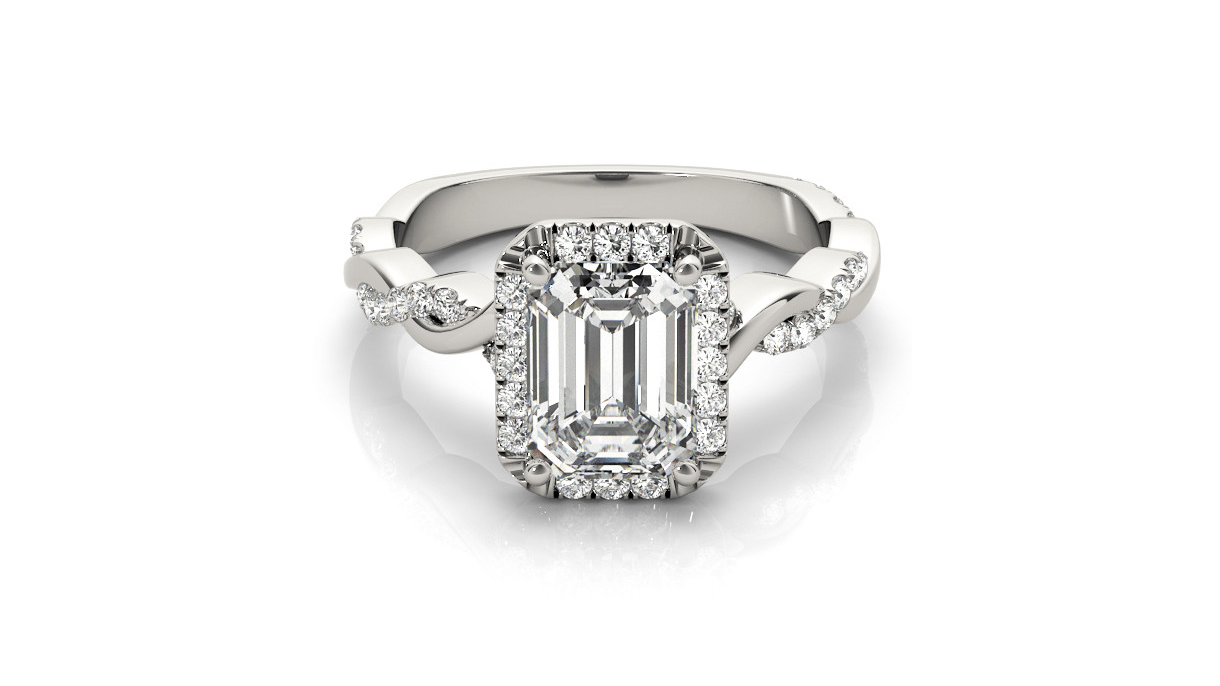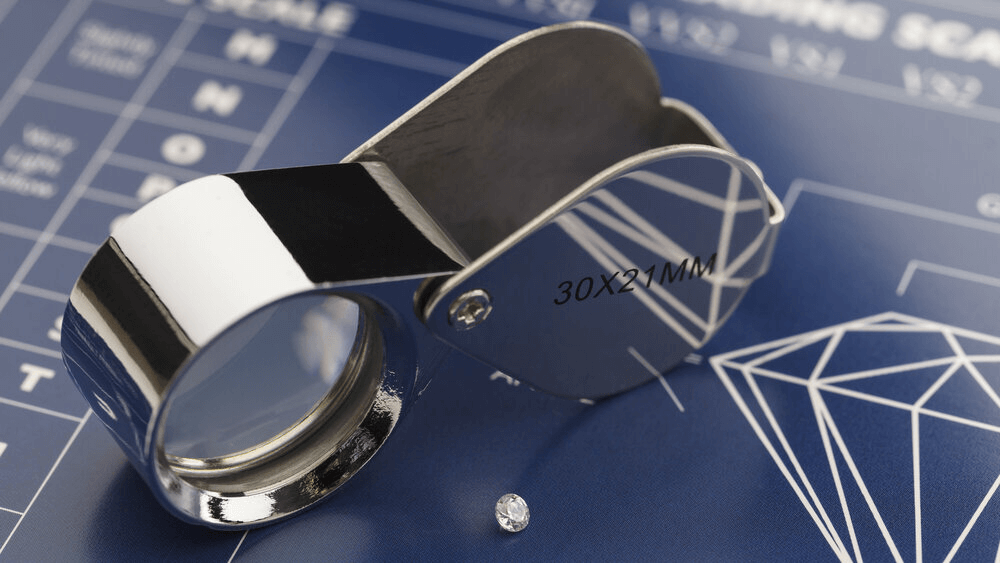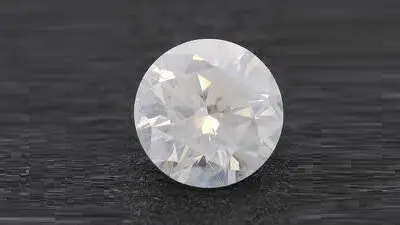VVS2 Diamonds: Get More Glam for Your Cash

By Gary A.

Edited by Olivia H.
Published Nov 15, 2023
Edited on Mar 31, 2025
A VVS2 diamond offers near-perfect clarity for those seeking brilliance in an engagement ring without the premium of flawless stones.

Navigate This Guide:
- 7 Quick Tips for Choosing a VVS2 Diamond Engagement Ring
- Introduction to VVS2 Diamonds
- Understanding Diamond Clarity: From Flawed to Flawless
- The VVS2 Debate: Balancing Quality and Cost
- Our Expert Take
- 20 Frequently Asked Questions (FAQs)
Before we dive deeper into the specifics, here are some practical tips to help guide your decision-making process:
7 Quick Tips for Choosing a VVS2 Diamond Engagement Ring
When embarking on the journey of selecting the perfect diamond engagement ring, especially focusing on VVS2 clarity, it’s essential to arm yourself with expert advice. Below, discover invaluable tips that ensure a balance between quality, value, and breathtaking brilliance.
- Tip 1: High Clarity is Crucial for Certain Cuts, Especially Emerald
- Recognize that the emerald cut, with its large, open table, can make inclusions and flaws more visible, demanding a higher clarity grade like VVS2.
- Acknowledge that due to the step-cut nature of emerald and Asscher shapes, these diamonds do not conceal imperfections as readily as brilliant-cut diamonds, making clarity a priority.
- Consider investing in a VVS2 diamond when opting for an emerald cut, as this high clarity ensures any natural inclusions are nearly invisible, maintaining the gem’s exquisite appeal.
- Remember, the need for higher clarity goes hand-in-hand with the cut’s unique ability to showcase a diamond’s genuine character, making the clarity choice integral to the overall aesthetic value.
- Tip 2: Understand the Clarity Grading Scale
- Familiarize yourself with the GIA clarity grading scale to understand where VVS2 falls and how it compares with other grades.
- Recognize that VVS2 signifies “Very, Very Slightly Included 2,” reflecting high clarity with minuscule inclusions hard to identify even under 10x magnification.
- Tip 3: Examine the Diamond Certificate
- Always request a diamond grading report from reputable labs like GIA or AGS.
- Verify the authenticity of the certificate by cross-referencing the report number with the online database of the issuing lab.
- Tip 4: Balance the 4Cs
- While clarity is important, remember to balance all 4Cs: cut, color, clarity, and carat weight.
- Understand that a higher clarity grade like VVS2 often comes at a premium and consider if you might be satisfied with a slightly lower grade without noticeable differences.
- Tip 5: View the Diamond in Person or Use High-Resolution Imagery
- If possible, examine the diamond in person under different lighting conditions to check its brilliance and fire.
- For online purchases, opt for retailers providing high-resolution images or 360-degree videos, allowing you to virtually inspect the diamond.
- Tip 6: Prioritize Cut Quality
- Prioritize the diamond’s cut, as it significantly impacts its overall brilliance.
- Even a high-clarity diamond like a VVS2 can appear dull if the cut quality is poor.
- Tip 7: Be Mindful of the Ring’s Setting
- Consider how the diamond will sit in the ring’s setting, as certain designs might hide inclusions or enhance the stone’s appearance.
- Remember, intricate settings like a halo or pave can be more forgiving with clarity and color as they mask slight imperfections.
Now that you’ve got these practical tips, use Jeweler AI below to find the perfect engagement ring that suits your style and budget:
Introduction to VVS2 Diamonds
VVS2 diamonds are about halfway down the GIA’s clarity scale. It’s a few steps down from the most revered grades of all – the perfect, flawless grades of FL and IF. Then again, it’s still a way off from the poorest quality grades of I2 and I3. If you’re looking for your ‘Goldilocks spot’ on the clarity scale, then there’s every reason to believe that VVS2 is the place to be.
But it’s not quite as simple as that. VVS2’s position as the ‘happy middle ground’ between one extreme and the other means that it comes at a premium, and may well be more quality than you really need.
Confused? We’ll explain…
Understanding Diamond Clarity: From Flawed to Flawless
Clarity is graded by the GIA using the following scale:
- Flawless (FL)
- Internally Flawless (IF)
- Very Very Slight Inclusions (VVS1 and VVS2)
- Very Slight Inclusions (VS1 and VS2)
- Slight Inclusions (SI1 and SI2)
- Inclusions (I1, I2, and I3)
VVS2 may be halfway down the scale (just about), but it’s still part of the closest possible classification after the flawless grades.
Very Very Slight Inclusions mean that these flaws are difficult for a skilled diamond grader to identify even under 10x magnification. So, while they are technically visible under lab conditions, there is no risk of these inclusions being visible to the naked eye – even for someone with a lot of experience in diamonds.
Essentially, VVS2 diamonds are almost as close to Flawless as you can get without dropping six- or seven-figures on a perfect diamond – and that’s not something the average engagement ring shopper wants or needs.

The VVS2 Debate: Balancing Quality and Cost
There are a lot of pros running in favor of the VVS2 clarity grade. It’s a lot cheaper than the grades that come before it on the GIA’s scale, it’s not all that rare, and it guarantees an eye clean diamond even if you’re looking at a pretty high carat weight.
All good things. But…
VVS2 is still significantly more expensive than the grades that follow it. Why? Because, to a lot of shoppers who want to make sure they avoid included diamonds, VVS1 and VVS2 seem like the ideal solution. The thing is, there are plenty of eye clean options below the VVS grades, too.
VS1, VS2, SI1, SI2 and, for smaller diamonds, I1 all produce plenty of eye clean options, and they’re a lot less expensive than VVS2 equivalents – at times, by thousands of dollars.
Is a VVS2 Diamond Worth the Investment?
Maybe. Let’s say you’ve got a very open-ended budget, know the carat weight you want and find that, even with high grades for Cut and Color you’ve still got plenty of money to play with, VVS2 isn’t going to be a wrong choice.
Even so, there are other things worth investing your money into. You could pay for a more elaborate setting, a bigger diamond, or put that leftover budget toward the wedding band or wedding itself.
But we’re not going to tell you how to spend your money. If you find the perfect diamond and can afford it happily, don’t turn your back on it just because it’s VVS2. But, if you’re looking to find a diamond that gets you the most of everything for your (limited) money, don’t focus on VVS2 diamonds. Look further down the scale instead.

Eye Clean and Sparkling: VVS2 vs the Rest of the Clarity Scale
Visibly, you won’t spot any difference between a VVS2 diamond and an IF diamond – but you also won’t spot any difference between a VVS2 diamond and any eye clean diamond, whether it’s been graded IF or Si2.
Higher clarity diamonds don’t sparkle more. Only major inclusions like clouds or large black spots impact a diamond’s light performance, and you’d have to be looking at I2 and I3 diamonds to get clarity that poor.
Beyond Clarity: How VVS2 Diamonds Fare in Overall Appeal
VVS2 diamonds are popular, but they’re not as popular as the VS range – and, in some cases, the SI range, too.
VS1 and VS2 diamonds are some of the most desirable on the market since they marry together the importance of eye cleanliness with the importance of finding a diamond within your price range. With the average budget for an engagement ring being around $6,000-$7,000 in the US, an affordable, eye clean diamond with a good carat weight is relatively easy to find with the VS1, VS2, SI1 and even SI2 grades.
VVS2 is a lot more expensive, so finding a VVS2 diamond at that budget would mean sacrificing on carat weight. Most savvy shoppers don’t want to do that.
Our Expert Take
VVS2 isn’t the right grade for everyone. It means paying a much higher price than you would need to in order to walk away with a beautiful, eye clean, good quality diamond.
Yes, it’s comforting to situate yourself so close to the flawless diamonds, but that doesn’t offer much value for money given the premium prices charged for VVS1 and VVS2 diamonds. There’s a lot more value at the VS and SI grades – unless, of course, you’re shopping with a bottomless budget and want to pay for the prestige that comes with a VVS2 diamond.
20 Frequently Asked Questions (FAQs)
- Q1: Is a VVS2 diamond good?
A1: Yes, a VVS2 diamond is considered very high quality. It has very, very slight inclusions that are difficult to see even under 10x magnification, making it nearly flawless to the naked eye. - Q2: Is VVS2 a real diamond?
A2: Absolutely. VVS2 is a clarity grade given to real diamonds by the Gemological Institute of America (GIA) and other grading bodies, indicating very high clarity. - Q3: What is better, VS1 or VVS2?
A3: VVS2 diamonds have fewer and less noticeable inclusions than VS1 diamonds, making them higher in clarity. However, the difference is often imperceptible to the naked eye. - Q4: What does VVS2 mean in a diamond?
A4: VVS2 stands for “Very, Very Slightly Included 2,” indicating that the diamond has very small inclusions that are difficult for even trained graders to see under 10x magnification. - Q5: How much is a VVS2 diamond worth?
A5: The price of a VVS2 diamond varies based on factors like carat weight, cut, and color. On average, a 1-carat VVS2 diamond can range from $5,000 to $10,000. - Q6: How rare is a VVS2 diamond?
A6: VVS2 diamonds are relatively rare compared to lower clarity grades but are more common than VVS1 and Flawless diamonds. - Q7: Is a VVS2 diamond eye-clean?
A7: Yes, VVS2 diamonds are generally eye-clean, meaning inclusions are not visible to the naked eye. - Q8: Which diamond clarity is best?
A8: The best diamond clarity is Flawless (FL) or Internally Flawless (IF). However, these are extremely rare and expensive. VVS1 and VVS2 are also excellent choices for high clarity. - Q9: Is VVS2 better than VVS1?
A9: VVS1 is slightly better than VVS2 in terms of clarity, as it has fewer and smaller inclusions. However, the difference is often negligible to the naked eye. - Q10: What is better than VVS2?
A10: VVS1, Internally Flawless (IF), and Flawless (FL) are all higher clarity grades than VVS2, with progressively fewer inclusions. - Q11: Is it worth getting a VVS1?
A11: It depends on your budget and preferences. VVS1 diamonds are of higher clarity than VVS2 and may be worth it if you seek the best quality. However, VVS2 diamonds offer excellent clarity at a slightly lower cost. - Q12: How can I ensure I’m buying a genuine VVS2 diamond?
A12: Always buy from reputable jewelers and request a grading report from a trusted lab like GIA or AGS. Verify the report number with the lab’s online database. - Q13: Are VVS2 diamonds suitable for engagement rings?
A13: Yes, VVS2 diamonds are an excellent choice for engagement rings due to their high clarity and brilliant appearance. - Q14: Can I see inclusions in a VVS2 diamond without a magnifying glass?
A14: No, inclusions in a VVS2 diamond are typically not visible to the naked eye and require magnification to be seen. - Q15: Does a VVS2 diamond sparkle more than other diamonds?
A15: Sparkle is more influenced by a diamond’s cut than its clarity. A well-cut VVS2 diamond will sparkle brilliantly, but so will a well-cut diamond of a lower clarity grade. - Q16: What are the best shapes for VVS2 diamonds?
A16: VVS2 diamonds are versatile and suitable for most shapes, but they are particularly beneficial for step cuts like emerald and Asscher, which reveal inclusions more easily. - Q17: How do VVS2 diamonds compare in price to other clarity grades?
A17: VVS2 diamonds are more expensive than VS1, VS2, and SI grades due to their higher clarity. However, they are less expensive than VVS1 and Flawless diamonds. - Q18: Can I save money by choosing a VS1 or VS2 diamond instead of a VVS2?
A18: Yes, you can save money by opting for a VS1 or VS2 diamond, especially if it is eye-clean, as the visual difference between these grades and VVS2 is minimal. - Q19: Why should I consider a VVS2 diamond over a lower clarity grade?
A19: If you value high clarity and minimal inclusions, and your budget allows, a VVS2 diamond offers a balance of high quality and visual appeal without the high cost of VVS1 or Flawless diamonds. - Q20: What should I look for in a diamond certificate for a VVS2 diamond?
A20: Ensure the certificate is from a reputable grading lab like GIA or AGS, and check the clarity grade, inclusions, and other 4Cs (cut, color, carat) details to verify the diamond’s quality.VVS2 Diamond engagement ring in box
Find your perfect VVS2 diamond with Jeweler AI. Achieve near-perfect clarity without breaking the bank and maximize your shopping experience.
FOLLOW-UP GUIDE SERIES





















